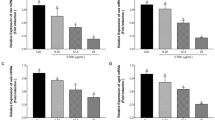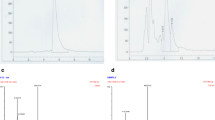Abstract
Ziziphus spina-christi L. (Sider) is a longstanding Arabian medicinal herb. The present study aimed to explore whether Ziziphus spina-christi leaves extract (ZSCLE) affects agr quorum sensing (QS) system and the phenotypic blood hemolytic activity regulated by this system in Staphylococcus aureus. The luciferase is encoded by plasmid pSB2035 in the reporter strain 8325–4, which is promoted by the agr P3 promoter. The result indicated that the total extract of (ZSCL) is effective against agr QS system in the reporter strain, where it reduces the lux gene expression up to 80.41% at a concentration of 0.25 mg/mL of total extract. Also, the hemolytic activity was reduced up to 98.9% by comparing with positive control by total extract. Successive extracts: hexane, diethyl ether, chloroform, ethyl acetate, and methanol were performed. The result revealed that the diethyl ether fraction was the greatest one that inhibited the production of both agr locus and the phenotypic hemolysin protein of S. aureus. Accordingly, phytochemical analysis in this total extract was performed and showed a high number of flavonoids and other compounds. FT-IR analysis of the most active fraction showed Monoelaidin as the main component of this fraction.






Similar content being viewed by others
Data Availability
All authors declare that the data supporting the findings of this study are available within the article.
References
Hossain, A.; Habibullah-Al-Mamun, M.; Nagano, I.; Masunaga, S.; Kitazawa, D.; Matsuda, H.: Antibiotics, antibiotic-resistant bacteria, and resistance genes in aquaculture: risks, current concern, and future thinking. Environ. Sci. Pollut. Res. 29, 1–22 (2022)
Elfaky, M.A.; Abdel-Hamid, M.I.; Khalifa, E.; Alshareef, W.A.; Mosbah, R.A.; Elazab, S.T., et al.: Innovative next-generation therapies in combating multi-drug-resistant and multi-virulent Escherichia coli isolates: insights from in vitro, in vivo, and molecular docking studies. Appl. Microbiol. Biotechnol. 106, 1691–1703 (2022)
Nassar, O.; Desouky, S.E.; El-Sherbiny, G.M.; Abu-Elghait, M.: Correlation between phenotypic virulence traits and antibiotic resistance in Pseudomonas aeruginosa clinical isolates. Microb. Pathog. 162, 105339 (2022)
Yousef, A.; Abu-Elghait, M.; Barghoth, M.G.; Elazzazy, A.M.; Desouky, S.E.: Fighting multidrug-resistant Enterococcus faecalis via interfering with virulence factors using green synthesized nanoparticles. Microb. Pathog. 173, 105842 (2022)
Johnson, D.I.: Bacterial virulence factors, p. 1–3. Bacterial pathogens and their virulence factors. Springer (2018)
JoGdM, P.; Fernandes, L.S.; dos Santos, R.V.; Tasic, L.; Fill, T.P.: Virulence factors in the phytopathogen–host interactions: an overview. J. Agric. Food Chem. 68, 7555–7570 (2020)
Rasko, D.A.; Sperandio, V.: Anti-virulence strategies to combat bacteria-mediated disease. Nat. Rev. Drug Discov. 9, 117–128 (2010)
Dickey, S.W.; Cheung, G.Y.; Otto, M.: Different drugs for bad bugs: antivirulence strategies in the age of antibiotic resistance. Nat. Rev. Drug Discov. 16, 457–471 (2017)
Escaich, S.: Antivirulence as a new antibacterial approach for chemotherapy. Curr. Opin. Chem. Biol. 12, 400–408 (2008)
Loss, G.; Simões, P.M.; Valour, F.; Cortês, M.F.; Gonzaga, L.; Bergot, M., et al.: Staphylococcus aureus small colony variants (SCVs): news from a chronic prosthetic joint infection. Front. Cell. Infect. Microbiol. 9, 363 (2019)
Tong, S.Y.; Davis, J.S.; Eichenberger, E.; Holland, T.L.; Fowler, V.G., Jr.: Staphylococcus aureus infections: epidemiology, pathophysiology, clinical manifestations, and management. Clin. Microbiol. Rev. 28, 603–661 (2015)
El-gamal, M.S.; Desouky, S.E.; Hassan, S.E.; Elghait, M.A.: Phenotypic and biochemical characterization of specific virulence determinants regulated by agr quorum sensing system in Staphylococcus aureus. Al Azhar Bull Sci. 9, 217–226 (2017)
Chatterjee, A.; Rai, S.; Guddattu, V.; Mukhopadhyay, C.; Saravu, K.: Is methicillin-resistant Staphylococcus Aureus infection associated with higher mortality and morbidity in hospitalized patients? A cohort study of 551 patients from South Western India. Risk Manage. Healthcare Policy. 11, 243 (2018)
Striednig, B.; Hilbi, H.: Bacterial quorum sensing and phenotypic heterogeneity: how the collective shapes the individual. Trends Microbiol. 30, 379–389 (2022)
Ganesh, P.S.; Veena, K.; Senthil, R.; Iswamy, K.; Ponmalar, E.M.; Mariappan, V., et al.: Biofilm-associated Agr and Sar Quorum sensing systems of Staphylococcus aureus are Inhibited by 3-hydroxybenzoic acid derived from Illicium verum. ACS Omega 7, 14653–14665 (2022)
Chevalier, C.; Boisset, S.; Romilly, C.; Masquida, B.; Fechter, P.; Geissmann, T., et al.: Staphylococcus aureus RNAIII binds to two distant regions of coa mRNA to arrest translation and promote mRNA degradation. PLoS Pathog. 6, e1000809 (2010)
Tam, K.; Torres, V.J.: Staphylococcus aureus secreted toxins and extracellular enzymes. Microbiol. Spectr. 7, 16 (2019)
Okba, M.M.; Baki, P.M.A.; Abu-Elghait, M.; Shehabeldine, A.M.; El-Sherei, M.M.; Khaleel, A.E., et al.: UPLC-ESI-MS/MS profiling of the underground parts of common Iris species in relation to their anti-virulence activities against Staphylococcus aureus. J. Ethnopharmacol. 282, 114658 (2022)
Desouky, S.E.; Abu-Elghait, M.; Fayed, E.A.; Selim, S.; Yousuf, B.; Igarashi, Y., et al.: Secondary metabolites of actinomycetales as potent quorum sensing inhibitors targeting gram-positive pathogens: in vitro and in silico study. Metabolites 12, 246 (2022)
Hamed, A.; Abdel-Razek, A.S.; Araby, M.; Abu-Elghait, M.; El-Hosari, D.G.; Frese, M., et al.: Meleagrin from marine fungus Emericella dentata Nq45: crystal structure and diverse biological activity studies. Nat. Prod. Res. 35, 3830–3838 (2021)
Tan, L.; Li, S.R.; Jiang, B.; Hu, X.M.; Li, S.: Therapeutic targeting of the Staphylococcus aureus accessory gene regulator (agr) system. Front. Microbiol. 9, 55 (2018)
Chothani, D.L.; Vaghasiya, H.: A review on Balanites aegyptiaca Del (desert date): phytochemical constituents, traditional uses, and pharmacological activity. Pharmacogn. Rev. 5, 55 (2011)
Sharma, V.; Sarkar, I.N.: Leveraging biodiversity knowledge for potential phyto-therapeutic applications. J. Am. Med. Inform. Assoc. 20, 668–679 (2013)
CLSI. Clinical and Laboratory Standards Institute: Performance standards for antimicrobial susceptibility testing. In: 20th informational supplement. CLSI document M100-S20. (2020).
Okba, M.M.; El-Shiekh, R.A.; Abu-Elghait, M.; Sobeh, M.; Ashour, R.M.: HPLC-PDA-ESI-MS/MS Profiling and Anti-Biofilm Potential of Eucalyptus sideroxylon Flowers. Antibiotics. 10, 761 (2021)
Azhagu, R.R.; Gomathi, M.; Prakasam, A.; Priya, K.; Narayanayyar, V.; Mahesh, P., et al.: Preliminary phyto-chemical analysis and biological activity of Hyptis suaveolens (L.)(Lamiaceae). Pharma Innov. 6, 1032 (2017)
Leela, C.; Shashank, B.; Suresh, D.: Phytochemical screening of secondary metabolites of Euphorbia Neriifolia Linn. Global J. Res. Med. Plants Indigenous Med. 2, 292 (2013)
Ren, X.; Guo, X.; Liu, C.; Jing, S.; Wang, T.; Wang, L., et al.: Natural flavone hispidulin protects mice from staphylococcus aureus pneumonia by inhibition of α-hemolysin production via targeting AgrAC. Microbiol. Res. 261, 127071 (2022)
Cho, H.S.; Lee, J.-H.; Cho, M.H.; Lee, J.: Red wines and flavonoids diminish Staphylococcus aureus virulence with anti-biofilm and anti-hemolytic activities. Biofouling 31, 1–11 (2015)
Soliman, M.K.; Salem, S.S.; Abu-Elghait, M.; Azab, M.S.: Biosynthesis of silver and gold nanoparticles and their efficacy towards antibacterial, antibiofilm, cytotoxicity, and antioxidant activities. Appl. Biochem. Biotechnol. 195, 1158–1183 (2023)
Rahman, M.; Sarker, S.D.: Antimicrobial natural products. Annual Reports in Medicinal Chemistry, p. 77–113. Elsevier (2020)
Brannon, J.R.; Hadjifrangiskou, M.: The arsenal of pathogens and antivirulence therapeutic strategies for disarming them. Drug Des. Dev. Ther. 10, 1795 (2016)
Soliman, M.K.; Abu-Elghait, M.; Salem, S.S.; Azab, M.S.: Multifunctional properties of silver and gold nanoparticles synthesis by Fusarium pseudonygamai. Biomass Conver. Biorefinery 1–18 (2022)
Ads, E.N.; Rajendrasozhan, S.; Hassan, S.I.; Sharawy, S.M.S.; Humaidi, J.R.: Phytochemical, antimicrobial and cytotoxic evaluation of Ziziphus spina-christi (L.) stem bark. Biomed. Res. 28, 6646–6653 (2017)
Ali, A.B.; Almagboul, A.Z.; Mohammed, O.M.: Antimicrobial activity of fruits, leaves, seeds and stems extracts of Ziziphus spina-christi. Arabian J. Med. Aromat. Plants 1, 94–107 (2015)
Motamedi, H.; Safary, A.; Maleki, S.; Seyyednejad, S.: Ziziphus spina-christi, a native plant from Khuzestan, Iran, as a potential source for discovery new antimicrobial agents. Asian J. Plant Sci. 8, 187 (2009)
Dangoggo, S.; Hassan, L.; Sadiq, I.; Manga, S.: Phytochemical analysis and antibacterial screening of leaves of Diospyros mespiliformis and Ziziphus spina-christi. J. Chem. Eng. 1, 31–37 (2012)
Abalaka, M.; Mann, A.; Adeyemo, S.: Studies on in-vitro antioxidant and free radical scavenging potential and phytochemical screening of leaves of Ziziphus mauritiana L. and Ziziphus spinachristi L. compared with Ascorbic acid. J. Med. Genet. Genomics 3, 28–34 (2011)
Barbosa-Pereira, L.; Pocheville, A.; Angulo, I.; Paseiro-Losada, P.; Cruz, J.M.: Fractionation and purification of bioactive compounds obtained from a brewery waste stream. BioMed Res. Int. (2013). https://doi.org/10.1155/2013/408491
Olchowik-Grabarek, E.; Sekowski, S.; Bitiucki, M.; Dobrzynska, I.; Shlyonsky, V.; Ionov, M., et al.: Inhibition of interaction between Staphylococcus aureus α-hemolysin and erythrocytes membrane by hydrolysable tannins: structure-related activity study. Sci. Rep. 10, 1–14 (2020)
Acknowledgements
This work was funded by the University of Jeddah, Jeddah, Saudi Arabia, under Grant No. (UJ-21-ICI-7). The authors, therefore, acknowledge with thanks the University of Jeddah technical and financial support.
Author information
Authors and Affiliations
Contributions
MYR was involved in methodology, data recording, writing the manuscript, AME helped in methodology, chemical data analysis, writing the review, data reviewing, MA-E contributed to conceptualization, methodology, writing the first draft, data reviewing, SE helped in conceptualization, data reviewing, JN contributed to data reviewing, consultant.
Corresponding author
Ethics declarations
Conflict of interest
The authors declare that they have no conflict interests.
Ethical Approval
This article does not contain any studies with human participants performed by any of the authors.
Consent to Participate
Authors understand that their participation is voluntary.
Consent to Publish
Authors give their consent for the publication of the article to be published in the Journal.
Rights and permissions
Springer Nature or its licensor (e.g. a society or other partner) holds exclusive rights to this article under a publishing agreement with the author(s) or other rightsholder(s); author self-archiving of the accepted manuscript version of this article is solely governed by the terms of such publishing agreement and applicable law.
About this article
Cite this article
Refai, M.Y., Elazzazy, A.M., Abu-Elghait, M. et al. Ziziphus spina-christi (L.) Willd. Leaves Extract Affecting agr Quorum Sensing System in Staphylococcus aureus. Arab J Sci Eng 49, 97–105 (2024). https://doi.org/10.1007/s13369-023-08404-5
Received:
Accepted:
Published:
Issue Date:
DOI: https://doi.org/10.1007/s13369-023-08404-5




